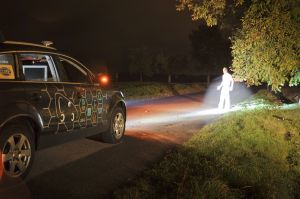Wet leaves, fog, rain, and early darkness in particular make the roads dangerous and the life of many car drivers difficult during the winter months. An innovative technology of KIT brings light into darkness: At the Institute of Measurement and Control headed by Professor Christoph Stiller, Marko H. Hörter has a developed a driver assistance system that light-marks persons and animals at the road side, as a result of which they can be detected much earlier.
Seeing and be seen are important in road traffic during the night. “In particular when driving during dusk, the probability of having an accident with a pedestrian, bicycle rider, or deer increases exponentially,” says Marko H. Hörter. Existing driver assistance systems are based on infrared cameras and the driver has to watch the images on a display. “A driver is distracted and this may cost valuable response time.” For this reason, Hörter’s technology goes a step further: A complex mechatronic system takes over image analysis in a fully automatic manner and, if necessary, light-marks potential hazards at the road side with a very precise light spot of very bright LED lamps. In this way, the driver’s attention is caught without the driver having to divert the eyes from the road.
A practical test of two weeks’ duration with 33 test participants on a country road near Bad Bergzabern confirmed that the new technology increases the safety of road traffic during the night. Using heatable deer and human dummies, Hörter compared the perception time of drivers and resulting perception distance with and without driver assistance system. The result: Light-marking increases the perceptibility of danger by 35 to 40 m and gives drivers two to three seconds more to react.
The development required four years of work and a participation of twelve students. The infrared camera installed in the engine hood of the test vehicle is only the start of the detection and marking process. The key of the innovation is subsequent computing power: “While driving, an enormous data volume has to be analyzed as quickly as possible. To achieve this was one of the major problems,” explains Marko H. Hörter. The computer that examines every individual image of the infrared camera in less than 40 milliseconds is able to distinguish persons and animals from other objects. In addition, it can determine their real 3 D position, speed, and direction from the 2 D images and calculate the risk of collision. A signal is transmitted to the light system in case of imminent danger only. There, a movable system directs the spot precisely and in a glare-free manner. The blinking, blue-white light light-marks the potential danger specifically.
The Mobility Systems Center pools KIT activities relating to vehicle technology. Presently, 40 KIT institutes with about 800 employees are working on methodological and technical fundamentals for tomorrow’s vehicles. It is their objective to develop energy-efficient, low-emission, and safe vehicles and mobility concepts. The researchers also consider the complex interactions of vehicle, driver, traffic and society.
In close partnership with society, KIT develops solutions for urgent challenges – from climate change, energy transition and sustainable use of natural resources to artificial intelligence, sovereignty and an aging population. As The University in the Helmholtz Association, KIT unites scientific excellence from insight to application-driven research under one roof – and is thus in a unique position to drive this transformation. As a University of Excellence, KIT offers its more than 10,000 employees and 22,800 students outstanding opportunities to shape a sustainable and resilient future. KIT – Science for Impact.

